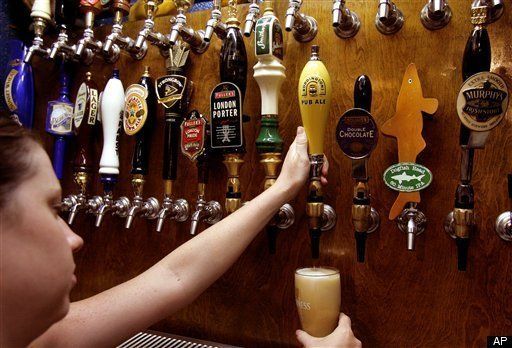
Here it is, the onset of flu season. I was worried about a succession of beer pourers at the Great American Beer Festival (GABF) touching my tasting glass, possibly infecting me with some sort of swine illness.
Yet, despite all that, there I was -- drinking a beer partially made from, well, someone else's spit.
As the sign put it at the booth for Dogfish Head -- Delaware's ever-experimental and envelope-pushing brewery -- Chicha is "a traditional Peruvian corn beer brewed with molle tree seeds, strawberries, and organic purple corn that we chewed to allow the ptyalin enzyme in our saliva [to] convert starch into sugar pre-boil." [Emphasis added.]
Disgusting, you say?! Well, ptooey to you! It was a pleasant brew with intriguing, interlocking flavors across the tongue. I detected a hint of purple (from the corn) in its otherwise golden hue, a slight sweetness from the strawberries, and a whiff of honey in the bouquet. (Here's a YouTube video explaining Dogfish Head's brew.)
The long lines to try Chicha and other unique brews at Dogfish Head's booth never died down. The GABF may have expanded its square footage this year -- which helped to reduce the jostling somewhat -- but that didn't necessarily make the sampling of storied beers any easier. There were always lengthy waits to taste, for instance, the wildly-popular sour beers of Wisconsin's New Glarus and California's Russian River.
Luckily, there were lots of lesser-known yet worthy beers to try, especially for a thirsty -- and antsy -- guy like myself. This year's GABF offered 2,100 selections from the combined 457 American breweries present. A three-day, sold-out event. Most of the convention-hall floor was devoted to row after row of beers, spotlighting various regions of the United States. Like a lager and ale Olympics, there were gold, silver and bronze medals awarded in 78 categories. (Go "Rocky Mountain" region! Go!)
But the GABF isn't just about drinking beer. (Oh really?, you might be asking.) As its sponsoring organization the Brewers Association explains it, part of the GABF's mission is to educate the public about craft beer and how it's made -- as well as to entertain.
Rooms are temporarily erected within the Colorado Convention Center using sound-proof, Plexiglas-like partitions. In one pavilion, cooking classes featured top brewers and chefs. Another held a sound stage on which brewers discussed their craft, while being filmed for later broadcast by The Brewing Network.
Just like having its own Tattered Cover on the premises, the GABF's bookstore came complete with signings by authors. Its tables of wares held 25 or so titles, including Brew Like a Monk , Joe Sixpack's Philly Beer Guide, and Ambitious Brew: The Story of American Beer. The reading selection stood as a testament to how books about beer have increased in volume since 1977.
That's the year The World Guide to Beer by the late British journalist Michael Jackson was first published. Jackson was adept at educating and entertaining beer drinkers himself. Some old-school GABF brewers, no doubt, first learned about unique beer styles (now featured at the GABF) due to reading about them in the Bard of Beer's books. Like a Patron Saint of Brewski, a massive photo banner of Jackson hung from the hall's ceiling, his image smiling down on the event he championed and frequently traveled from across the Atlantic to attend.
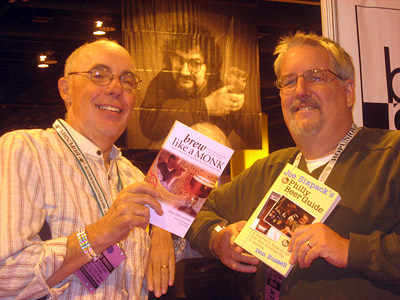
Beer writers Stan Hieronymus (left) and Don Russell (right). Looking down on the proceedings is the image of Michael Jackson, the late British journalist who pioneered writing about beer.
Who better than Denver's Mayor John Hickenlooper, the former beer entrepreneur, to toast festival goers from the main stage, prior to Saturday's awards ceremony? After all -- as Hickenlooper put it himself -- you get a lot of practice making toasts if you're the mayor. Hickenlooper offered a salute, followed by a swallow of beer. Call it Hickenlooper's own "beer summit" -- under much more pleasant and relaxed circumstances than President Obama's.
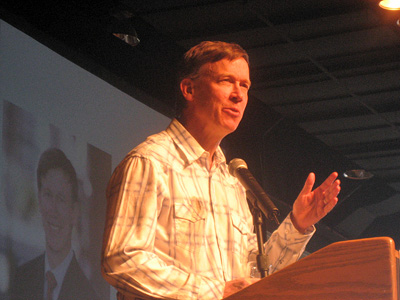
Denver Mayor John Hickenlooper, holding a glass of beer, provided a toast to the assembled masses.

Other visiting dignitaries included Marge and Homer Simpson, who celebrated 20 years of The Simpsons with festivalgoers. (Homer seems to be asking, "Where's the Duff Beer booth?")
After the award winners had been announced, it turned out that Colorado had won more medals this year than any other state! (It helps that there are categories geared towards macro -- rather than just micro -- brewers, like Coors and Miller, otherwise California would have overtaken us.)
Not only did the big, bad Coors Brewing Company win big ("Large Brewing Company and Large Brewing Company Brewer of the Year" award), the worthy, Coors-owned microbrewery The SandLot at Coors Field stood tall, as well, winning one gold and two silver medals in German-style categories. (The SandLot serves, in my mind, as a perfect example of why one shouldn't blame the child for the sins of its less flavorful parent.)
Imagine a Great Beer City? Okay, why not Aurora, then? Dry Dock Brewing Company of Aurora won the prestigious "Small Brewing Company and Small Brewing Company Brewer of the Year" award, due to its own victories: a gold medal and two silvers in German-style beer categories.
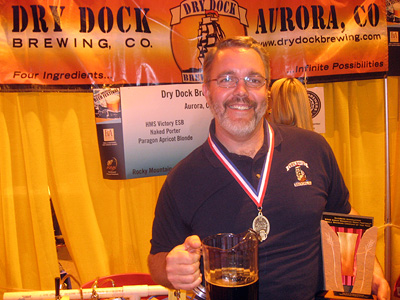
Kevin DeLange of Aurora's Dry Dock Brewing, holding his company's "Small Brewing Company and Small Brewing Company Brewer of the Year" award, while wearing a GABF gold medal.
Trinity Brewing Company of Colorado Springs won the gold medal in the "Experimental Beer" category. Trinity's TPS Report is tart, due to being fermented with a wild yeast strain. Tangerine, lemon, and lime zest are added to the brew. Then it's aged, not just in a barrel, but on rose petals as well.
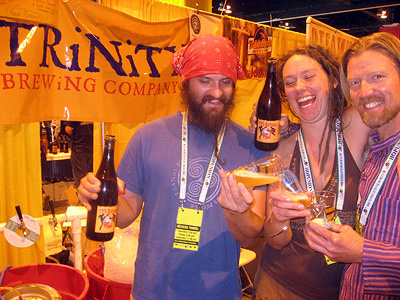
Trinity Brewing Company won the gold medal in the "Experimental Beer" category. Here, Trinity owner/head brewer Jason Yester (left) shares the award-winning brew.
What made Trinity's owner and head brewer Jason Yester want to create Belgian-inspired sour beers? (And who would have expected an award-winning brewer from conservative Colorado Springs to have dreadlocks clear down his back?)
Yester's answer, perhaps, ought to be a motto for all brewers:
"Who wants to make a boring beer, you know?"
That sentiment is nothing to spit at.
_____________________________________________________________________
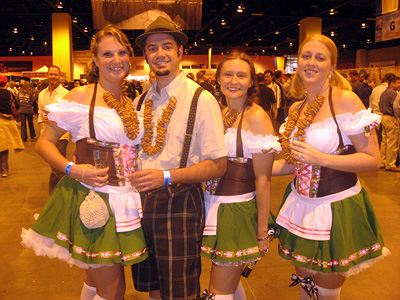
Will yodel for beer? Festival attendees often wear colorfully-themed costumes.
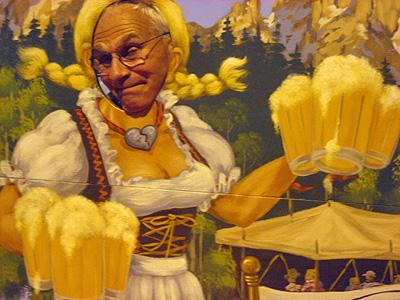
Peering through a photo-op cut-out display.
(All photos by Gregory Daurer)